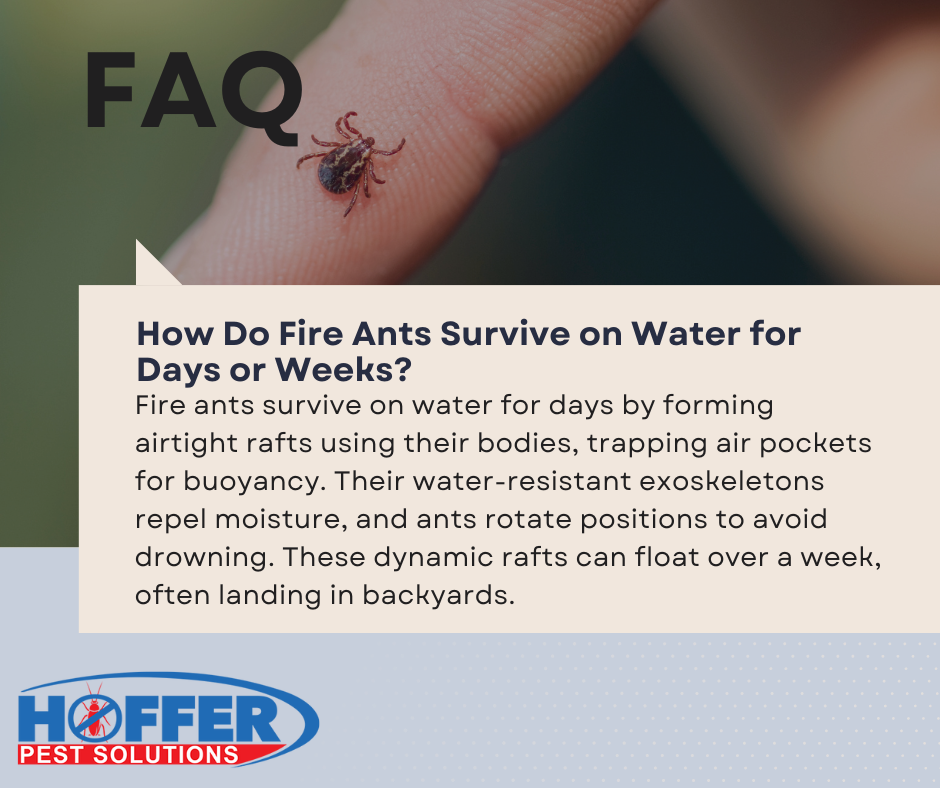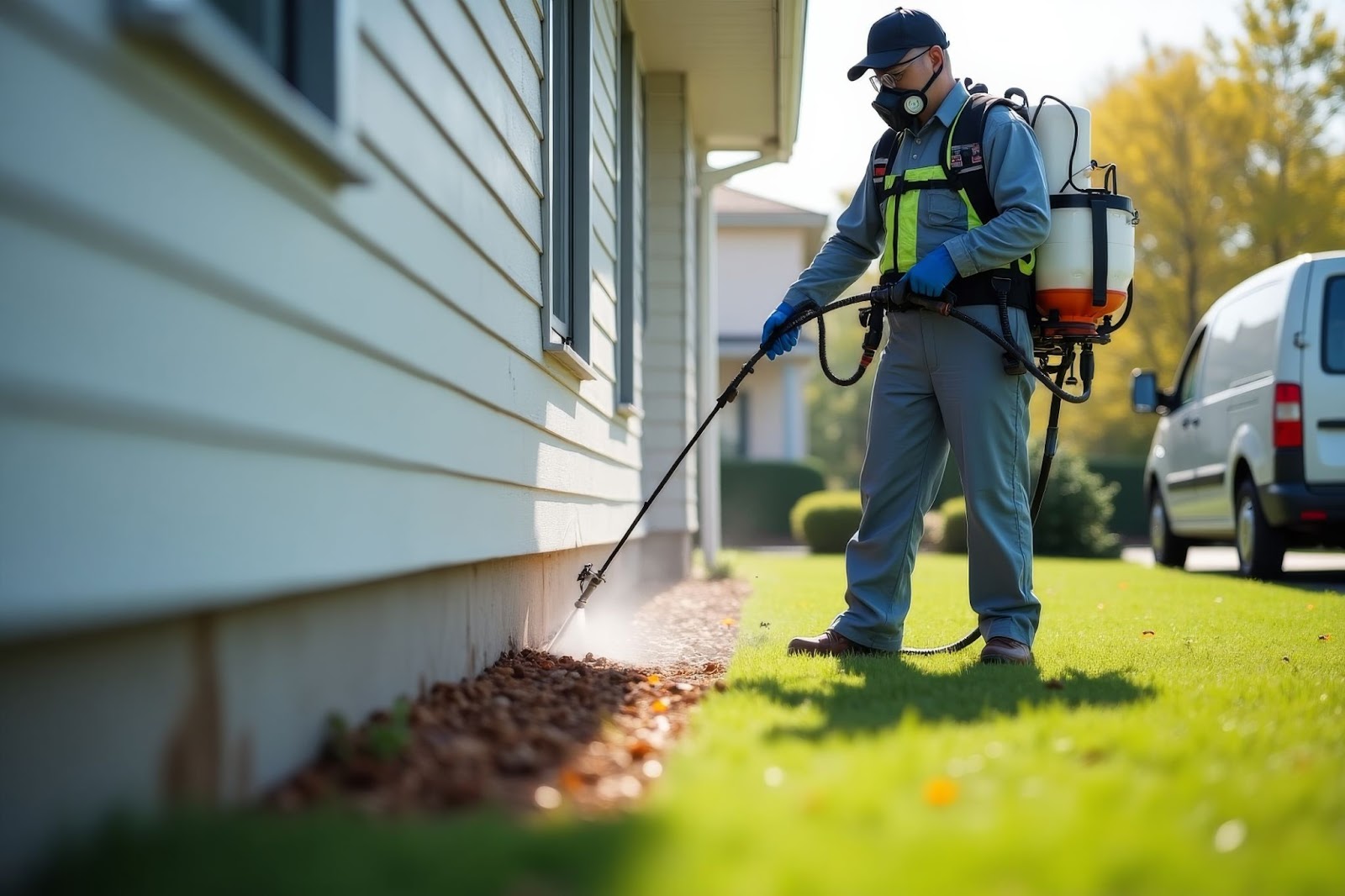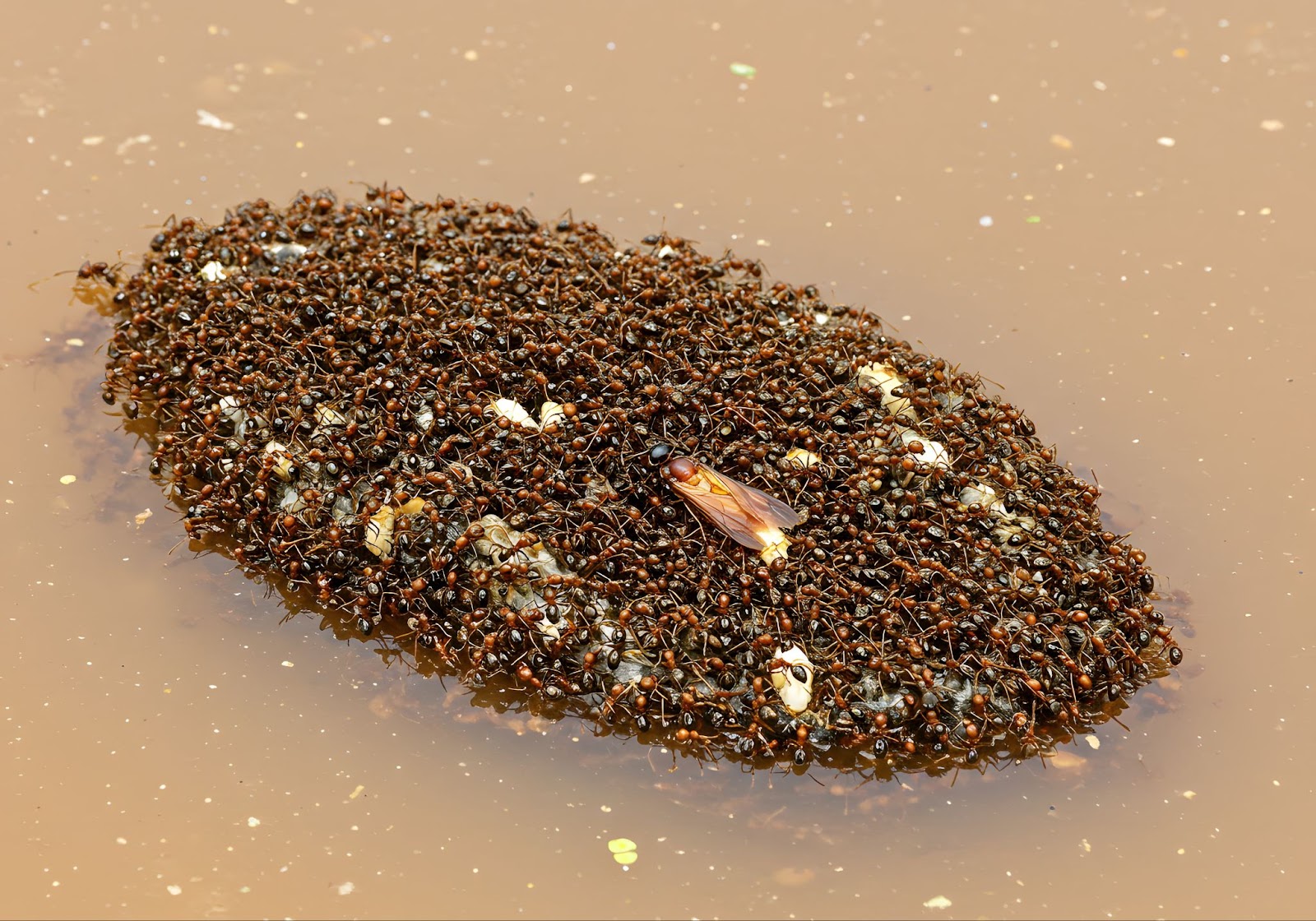Floating fire ants form waterproof rafts during floods by linking together. They can survive for days on water, attack in swarms when disturbed, and pose serious risks to people, pets, and property, especially in storm-prone areas.
These living structures can float for over a week, carrying thousands of ants, including the queen, across floodwaters and into your yard, garage, or home.
Here’s why that matters:
They attack in groups using synchronized, pheromone-triggered stings.
They’re dangerous to kids and pets, often hiding in puddles and debris.
Their stings can cause serious health issues, including allergic reactions.
DIY fixes like fire or gasoline often backfire, worsening the problem.
Professional help is essential when infestations spread or persist.
Spotting and stopping these colonies early is the key to avoiding painful stings and property damage.
In this guide, you’ll learn how to identify fire ant rafts, protect your home before and after storms, and know exactly when to bring in pest control experts.
If you live in a flood-prone area, this might be the most important guide you read this season.
Stick around, we’ll show you how to outsmart floating fire ants before they make your yard their next landing zone.
The Shocking Science Behind Fire Ant Rafts
What makes floating fire ants so terrifying isn't just the fact that they can float, it's how brilliantly they do it.
These insects have evolved one of nature's most adaptive survival mechanisms: transforming their entire colony into a living life raft.
And they do it all without a single command, blueprint, or leader.
1. A Living, Floating Life Raft
Fire ants lock themselves together using their mandibles and legs, forming a dense, waterproof mat.
This "raft" can support thousands of ants, the queen, and even the colony’s young as they drift across floodwaters.
2. No Leader, Just Perfect Instinct
Despite having a queen, there's no centralized decision-making.
Each ant reacts to touch-based cues, constantly adjusting and communicating through feel alone. This decentralized system lets them form stable structures under chaotic conditions.
3. Why the Raft Looks Like a Pancake
Their rafts naturally spread into a wide, flat disc.
This pancake shape increases buoyancy and helps prevent sinking by maximizing surface area, much like a lily pad on water.
4. When Rafts Become Towers
When these floating masses reach fences, plants, or buildings, fire ants shift tactics. They climb and build upward, forming temporary vertical towers to escape water.
These structures are not only protective but also strategically positioned to begin new nests once the floodwaters recede.
Fire ant rafts aren’t just clever, they’re engineered by instinct to survive.
But floating isn’t the whole story. What makes these colonies truly dangerous is how long they can last, and what happens while they drift.
How Do Fire Ants Survive on Water for Days or Weeks?

At first glance, a clump of floating fire ants might seem like a temporary accident, something nature didn’t plan for.
But that couldn’t be further from the truth.
These ants are built to endure the worst of conditions, and their ability to survive on open water for extended periods is nothing short of biological brilliance.
1. Built-in Buoyancy and Water Resistance
Each fire ant is equipped with a water-resistant exoskeleton that helps repel moisture. When they link together, the small air pockets trapped between their bodies add buoyancy.
This natural floatation system keeps the colony above water, even in rough conditions.
2. Raft Dynamics: More Than Just Floating
The raft isn’t a static blob, it’s a dynamic, shifting system. Ants on the bottom layer eventually rotate upward, while fresher ants cycle down.
This continuous living conveyor belt helps prevent drowning and distributes physical stress evenly across the colony.
So… How Long Can They Last?
Under the right conditions, fire ant rafts have been observed surviving for over a week, sometimes longer if they find debris or vegetation to climb on.
Their resilience in open water means they can travel surprisingly long distances before reaching land or structures to rebuild.
And unfortunately, when they finally find dry ground, it's often in someone's backyard.
Once these rafts land, they don’t quietly disperse. Disturb them, and what started as a drifting colony can instantly turn into a swarm of stinging attackers.
Why Fire Ants Attack, and What Makes Them So Dangerous
Floating fire ants aren’t aggressive by default, but when disturbed, their response is immediate and intense.
Their sting strategy, paired with how easily they’re encountered during floods, makes them a serious threat, especially for kids, pets, and anyone caught unaware.
Synchronized and Strategic Stings
Fire ants crawl first, sting later, releasing pheromones to trigger a group attack.
This delayed bite pattern ensures maximum impact and confusion.
The result: sudden, overwhelming pain that feels like a burn or electric shock.
A Defense That Feels Like an Ambush
Ants sting only when threatened, but in large numbers and with extreme aggression.
Many victims report being swarmed after brushing against a raft or stepping into puddles.
Real-World Reactions: ER Visits and Allergic Shocks
People have ended up in the emergency room with severe allergic reactions.
Stings can cause anaphylaxis, swelling, or long-lasting welts and scars.
Curious children and dogs are especially at risk in recently flooded areas.
Why They’re Extra Dangerous for Families
Fire ant rafts are easy to mistake for debris, especially in puddles or yards.
Pets and children often step or sniff before realizing the danger.
Multiple stings can lead to infections or serious complications if not treated quickly.
Post-Storm Safety Tips
Keep children and pets indoors after floods until areas are inspected.
Scan puddles, ditches, and yard edges for floating clusters or unusual movement.
If in doubt, avoid contact and assume it’s a fire ant raft.
The danger isn’t just in the sting, it’s in how easily these rafts go unnoticed.
To stay safe, you need to know what they look like, where they hide, and how to spot them before it’s too late.
How to Spot Fire Ant Rafts Before It’s Too Late
One of the most dangerous things about fire ant rafts?
They don't look dangerous.
In the aftermath of heavy rain or flooding, they blend right into the chaos, floating silently in places where you’d never expect trouble. Spotting them early is key to avoiding painful encounters.
What Do Fire Ant Rafts Look Like?
At a glance, they resemble mud clumps, mulch piles, or floating leaves.
On closer inspection, they’re shifting, writhing mats of live ants, moving as one unit.
You might see them in puddles, pooled water near driveways, or caught along fences and debris.
Where Are They Most Likely to Show Up?
Low-lying areas like ditches, storm drains, and flood-prone lawns.
Playgrounds and parks, especially sandboxes and mulch beds.
Along the edges of fences, trees, patio furniture, or anything left outdoors during a storm.
Be in Inspection Mode Post-Storm
After a flood or even heavy rain, walk your property with a careful eye.
Use gloves and tools, not bare hands, when moving debris or sifting through wet mulch.
Teach kids to avoid touching anything that looks like “mud that’s moving.”
Don’t Assume It’s Harmless
If you’re even slightly unsure about what you're seeing, don’t test it.
Rafts can contain tens of thousands of ants, and bumping one by accident can unleash a full-scale attack. Always better to treat the situation seriously than deal with stings after.
DIY or Call the Pros? The Smart Way to Protect Your Home from Floating Fire Ants

If you’ve ever discovered a swarm of floating fire ants in your yard after a storm, you know the panic it can cause. Some homeowners go straight to DIY methods, hoping to knock out the problem fast.
Others wait too long and end up with a full-blown infestation.
Knowing what works, what doesn’t, and when it’s time to call in professionals can save you time, money, and a lot of pain.
Why Some DIY Methods Backfire
When fire ants show up, it’s tempting to reach for quick fixes, but not all methods are effective, and some can make things worse. Here’s what to avoid and why:
Gasoline and fire tactics are dangerous:Pouring gasoline into mounds or trying to burn them can damage your soil, pollute groundwater, and pose serious safety risks, without reliably killing the queen or entire colony.
Granules often push ants elsewhere: Granular treatments might seem convenient, but they tend to scatter ants instead of eliminating them. In flood-prone areas, this can encourage raft formation or drive the colony deeper underground.
Flooding a mound with water doesn't stop them: Fire ants are built to survive rising water. Dousing a mound may only prompt them to raft and relocate, not drown.
Homemade sprays usually fall short: DIY mixtures like vinegar, soap, or boiling water might kill a few ants on contact, but they rarely reach the queen or solve the root of the problem.
Instead of relying on risky shortcuts, focus on proven solutions, especially those that are effective even when water is part of the equation.
Products like Suspend SC and Temprid FX offer professional-grade control, especially in flood-prone areas.
Liquid insecticides outperform granules in both depth and residual strength, making them the better choice for pre-flood mound treatments.
How to Build a Defense Plan That Actually Works
A three-phase approach, before, during, and after a storm, can go a long way in protecting your property:
Before the storm:
Identify and treat visible mounds with liquid insecticide.
Apply perimeter treatments around the foundation of your home.
Remove excess yard debris and clutter that could provide shelter.
During flooding:
Avoid all contact with floating rafts.
Keep children and pets indoors and away from standing water.
Do not move storm debris without proper gloves and long sleeves.
After the flood:
Survey your property for displaced colonies and signs of rafting.
Drain pooled water from containers, flower pots, and tarps.
Check high-risk zones like playgrounds, fence lines, and mulch beds for newly forming nests.
When It’s Time to Call in a Professional
Despite your best efforts, some infestations require expert help. If you’re dealing with:
Large, persistent colonies that reappear after treatment
Fire ant sightings indoors or near entry points
Evidence of nesting around foundations, crawl spaces, or HVAC units
then professional help is your best option.
A licensed pest control provider can assess the full extent of the infestation and use targeted treatments unavailable to homeowners.
Don’t Wait Until It’s Too Late
Floating fire ants aren’t just another pest problem—they’re a storm-driven threat that can strike without warning.
The biggest mistake homeowners make? Waiting too long to act, or believing that old myths and quick fixes will keep them safe.
The good news is, you don’t have to wait for a sting to take action.
By treating visible colonies before a storm, inspecting your yard after heavy rain, and knowing when to bring in professionals, you can stay ahead of the threat.
Protecting your family, your pets, and your home starts with awareness, and ends with the right response.
Don’t wait until someone gets stung to take this seriously.
If you’re in South Florida and want expert help with fire ants before, during, or after the storm, Hoffer Pest Solutions is here for you.
Our family-owned team specializes in fast, effective ant infestation removal tailored to Florida’s unique conditions.
We understand how local weather affects pest behavior and offer solutions that work. Schedule your inspection today and let us help you stay one step ahead.


